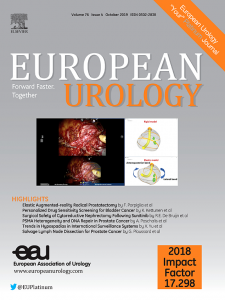European Association of Urology-European Society of Paediatric Urology Guidelines on Paediatric Urology: Summary of 2024 Updates. Part II
IF 25.3
1区 医学
Q1 UROLOGY & NEPHROLOGY
引用次数: 0
Abstract
Background and objective
We present a summary of part II of the 2024 update of the European Association of Urology (EAU)/European Society of Paediatric Urology (ESPU) guidelines on paediatric urology. The summary provides evidence-based standards for management of a number of urological conditions in the paediatric population. The aim is to provide practical recommendations for clinical management of these conditions with a focus on diagnosis, treatment, and follow-up.Methods
For the guidelines update, new and relevant evidence was identified, collated, and appraised via a structured assessment of the literature. Databases searched included Medline, EMBASE, and the Cochrane Libraries. Recommendations in the guidelines were developed by the panel to prioritise clinically important care decisions. The strength of each recommendation was determined according to a balance between desirable and undesirable consequences of alternative management strategies, the quality of the evidence (including the certainty of estimates), and the nature and variability of patient values and preferences.Key findings and limitations
Key recommendations emphasise the importance of thorough diagnosis, treatment, and follow-up for patients with the conditions outlines. The guidelines stress the importance of a multidisciplinary approach to treatment and the importance of shared decision-making with patients and their guardians/caregivers. The summary provides evidence-based standards for management of undescended testes, testicular tumours in prepubertal boys, acute scrotum, hypospadias, congenital penile curvature, urinary tract infections, daytime lower urinary tract conditions, urachal remnants, and transitional urology.Conclusions and clinical implications
Part II of the 2024 EAU/ESPU guidelines provides updated guidance for evidence-based management of a number of paediatric urological conditions, with recommendations designed for effective integration into clinical practice.求助全文
约1分钟内获得全文
求助全文
来源期刊

European urology
医学-泌尿学与肾脏学
CiteScore
43.00
自引率
2.60%
发文量
1753
审稿时长
23 days
期刊介绍:
European Urology is a peer-reviewed journal that publishes original articles and reviews on a broad spectrum of urological issues. Covering topics such as oncology, impotence, infertility, pediatrics, lithiasis and endourology, the journal also highlights recent advances in techniques, instrumentation, surgery, and pediatric urology. This comprehensive approach provides readers with an in-depth guide to international developments in urology.
 求助内容:
求助内容: 应助结果提醒方式:
应助结果提醒方式:


